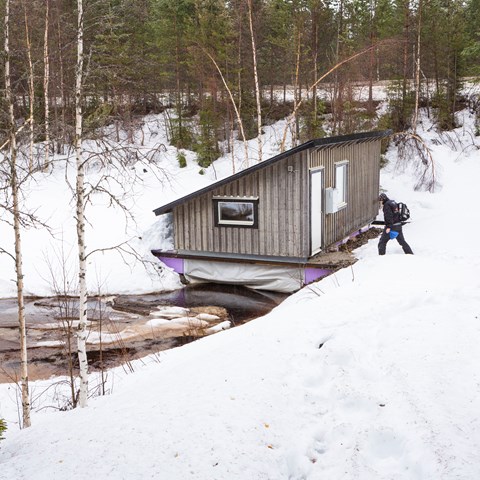Contact
The internal editorial office

The flowers bloom, the birds return - and SLU researchers compete to guess when the spring flood reaches its peak. Since 2011, a research group in Umeå has engaged in a prestigious wager to figure out when the water masses reach their maximum force.
Spring is a busy time for the researchers working in the Krycklan catchment area in Västerbotten outside Umeå. Many water samples need to be collected while nature is preparing for one of its main events: the mighty spring flood. Seeing rivers and streams raging and frothing while nature wakes from winter is a sign of spring for many people. But predicting when this will occur with any precision is a complicated matter, even for researchers.
"It varies a lot from year to year. The researchers working a lot in the field might have a leg up, but in the end it is mainly a guessing game", says Kim Lindgren on the Unit for Field-based Forest Research. The last couple of years, he has been in charge of a friendly betting game within the research group, an annual event since 2011. Guessing when the spring flood peaks is such a difficult task, it has proven itself a suitable subject for competition among researchers.
In one of the oldes sites of its kind in Kryckan called "C7", the water flow is measured continously to gather long series of research data. Researchers can track the flow via a website and also submit their wager for the date and time they believe the curve will reach its peak, along with the expected flow rate at that moment. This usually occurs sometime between mid-April and mid-May, and the maximum flow in recent years has varied between a modest 33 liters per second and over 200 liters per second. Those who come closest in one or both categories are rewarded.
"The winner gets a diploma and the glory at the yearly Krycklan symposium", says Kim Lindgren.
Virgina Mosquera, PhD-student at the department of Forest Ecology and Management, grew up in Guatemala, a country where the spring flood doesn’t exist as a phenomenon. When participating in the guessing game for the first time three years ago, she had to rely on the resources available. Namely the decades of data previously recorded in the Krycklan area. The result? She won the competition – twice in a row.
”During this time I worked a lot in the field. I saw how the snow, the sunlight and other factors were changing, and compared this to observations from previous years. I have joked with my colleagues and said it is thanks to witch craft, but in reality that is not the case”, she says. This year, Virginia Mosquera has decided not to participate, wanting to “finish on top”, as she puts it. But should she decide to try again, will her methods guarantee success? Not necessarily.
”With the changes in climate we also see changes in the spring flood, when it peaks and how intense it ultimately will be”, says Virginia Mosquera.
Spring flood is of major importance for hydrology and the plants and animals living in the areas it affects. The snow that has been accumulating for many months is released in a number of weeks, bringing with it sediments and nutrients to low laying areas. For the SLU-researchers in this area, this is one of the highlights of the years.
“It is such a powerful natural phenomenon and very special for this part of the world. Perhaps it deserves more attention”, says Virginia Mosquera.
Text: Daniel Stjärna
The internal editorial office